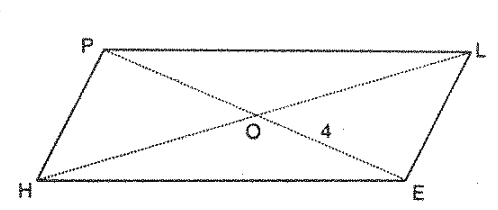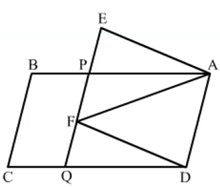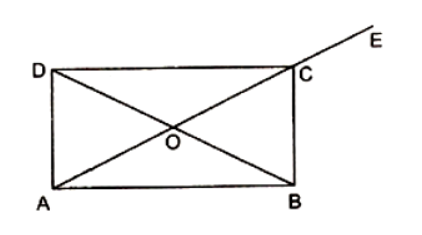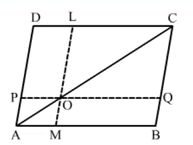In Figure, HELP
is a parallelogram. If OE=4cm and HL
is 5cm more then PE.
Find OH.

Step by step video & image solution for In Figure, H E L P is a parallelogram. If O E=4c m\ a n d\ H L is 5cm more then P Edot Find O Hdot by Maths experts to help you in doubts & scoring excellent marks in Class 8 exams.
Updated on:21/07/2023Topper's Solved these Questions
Similar Questions
In Figure, PQRS is a parallelogram, PO and QO are, respectively, the angle bisectors of ∠P and ∠Q . Line LOM is drawn parallel to PQ . Prove that: PL=QM (ii) LO=OM
View SolutionABCD is a parallelogram, E and F are the mid-points of AB and CD respectively. GH is any line intersecting AD, EF and BC at G, P and H respectively. Prove that GP=PH
View SolutionIn Figure ABCDandAEFD are two parallelograms. Prove that: PE=FQ

View SolutionIn Figure, ABCD is a rectangle in which diagonal AC is produced to E. If ∠ECD=1460, find ∠AOB

View SolutionIn Figure, ABCDandAEFD are two parallelograms? Prove that: ar(APE):ar(PFA)=ar(QFD):ar(PFD)

View SolutionP is any point on base BC of ABC and D is the mid-point of BC.DE is drawn parallel to PA to meet AC at E. If ar(ABC)=12cm2 , then find area of EQC
View SolutionIn Figure, ABCD is a parallelogram O s any point on AC, PQparallelAB and LMparallelAD
Prove that ar(parallelogram)DLOP)=ar(parallelogram BMOQ)
View SolutionIn Fig.97, If AB is parallel to CD, then the value of ∠BPE is (a) (b)(c)(d)(e)106(f)0(g)(h)(i) (j) (b) (k)(l)(m)(n)76(o)0(p)(q)(r) (s) (c) (d)(e)(f)(g)74(h)0(i)(j)(k) (l) (d) (m)(n)(o)(p)84(q)0(r)(s)(t) (u)
View SolutionL, M, N,O, P, Q, R and S are sitting around a circle facing the centre. N, who is third to the left of P, is not a neighbour of M. S is the neighbour of O and R and is third to the right of M. L is not the neighbour of O, who is second to the left of N.
Which of the following has the second person sitting between the remaining two?
1) M, L, P
2) N, L, Q
3) P, S, R
4) Q,N, L
5) None of these
View SolutionL, M, N,O, P, Q, R and S are sitting around a circle facing the centre. N, who is third to the left of P, is not a neighbour of M. S is the neighbour of O and R and is third to the right of M. L is not the neighbour of O, who is second to the left of N.
Which of the following is TRUE?
1) M is on the immediate right of P.
2) N is on the immediate right of L.
3) O is third to the right of L.
4) L is second to the right of Q
5) None of these
View Solution
